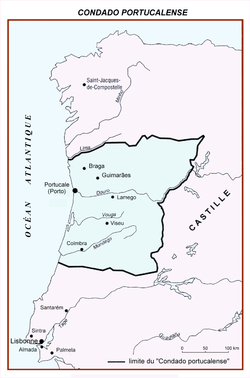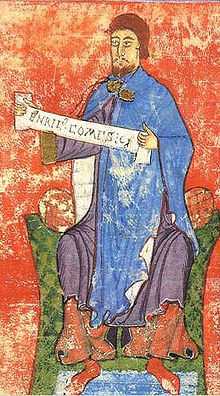Count of Portugal
Part of a series on the |
|---|
| History of Portugal |
 |
|
|
|
| Timeline |
| Portugal portal |


The Count of Portugal (Portuguese: Conde de Portucalense, Conde de Portucale) was the ruler of the County of Portugal, corresponding to the region around Braga and Porto in northern Portugal, from the late ninth to the early twelfth century, during which it was held in vassalage from the Kingdom of León. In this period the national identity of the Portuguese people was formed and the basis for the Portuguese independence was created.
Background
After the Muslim conquest of Hispania, the first steps in what has become known as the Christian Reconquista, was begun by bands led by Pelayo. Amid several steps back and forward, the Christian kingdoms of Asturias, and later León, Navarre, Aragon, Galicia and Castile managed to increasingly control larger parts of the peninsula, starting from the north.
The Kingdom of Asturias was established in 718 and lasted until 925. During some of this time, it ruled over territory that extended as far south as today's northern Portugal, as part of Galicia. In what is today's Portuguese territory, the lands between the rivers Minho. the Reconquista. Alfonso II of Asturias expanded the Kingdom, and sents parties deep into Moorish controlled territory, sacking Lisbon in 798. The Moors recovered from the raid and retained hold of Lisbon until 1147. The Moors pushed back and soon recovered most of the territory they had briefly lost, except for what is now northern Portugal.
History
First county
The Reconquista of Portucale (Porto) by count Vímara Peres occurred in 868, which is the traditional beginning of the county of Portugal, a county of the Kingdom of Galicia, which was a vassal kingdom of the Kingdom of Asturias. Further south, another border county was formed when more land was conquered from the moors: the County of Coimbra led by Hermenegildo Guterres, that would later be reconquered by the Moors. During this period, the two counties would suffer multiple attacks, but would also expand. Ferdinand I of León and Castile conquered Lamego in 1057, Viseu in 1058 and, finally, Coimbra in 1064. The county continued with varying degrees of autonomy within the Kingdom of León and, during brief periods of division, the Kingdom of Galicia until 1071, when Count Nuno Mendes was defeated and killed in the Battle of Pedroso by King García II of Galicia, who then proclaimed himself the King of Galicia and Portugal. An independent county was abolished with the territories remaining within the crown of Galicia, and following reunification the next year, that of León under Sancho II and Alfonso VI.
Portugal under Raymond of Burgundy
The Kingdom of Galicia, including Portugal and the former County of Coimbra, had been given by Alfonso VI to his son-in-law Raymond of Burgundy, but in 1096 Alfonso separated the County of Portugal from these lands and granted them, along with the County of Coimbra, to another son-in-law, Henry of Burgundy, wed to Alfonso VI's illegitimate daughter Theresa.[1][2] Henry based his newly formed county in Braga. In 1093 Lisbon was conquered by Alfonso VI of León and Castile.
Second county
The Second County of Portugal or Condado Portucalense, know at the time as Terra Portucalense or Província Portucalense,[3] was created in 1095 and was disestablished in 1139. Its territory included much of the current Portuguese territory between the Minho River and the Tagus River.[4]
After the arrival of Henry of Burgundy, cousin of Raymond, the territories of the former counties of Portucale and Coimbra were given to him, forming the Second County of Portugal. Count Henry continued the Reconquista in western Iberia and expanded his county's dominions. He was also involved in several intrigues inside the Leonese court, together with his cousin Raymond and his wife Urraca of Castile, in order to assure Portuguese independence and ascension to the throne by Raymond. In 1111 the Muslims conquered Santarém.[5] When Count Henry died in 1112, the population of the County of Portugal, including the powerful families, were favourable of independence. Henry's son and successor, Afonso Henriques, expanded the territory and assumed the royal title. He took the reins of the government in 1128, after routing forces of his mother in the Battle of São Mamede, near Guimarães. After this battle, he began to exhibit a seal with a cross and the word "Portugal". He continued to win battles, supported by the nobles of Entre-Douro-e-Minho, eventually triumphing in the Battle of Ourique in 1139, which led to his proclamation as King of Portugal. It was finally in 1143 when Alfonso VII recognized the de facto independence of Portugal in the Treaty of Zamora.
Counts
- First county
- Vímara Peres (868–73)
- Lucídio Vimaranes (873–???)
- Hermengildo Gonçalves (c.924–c.950)
- Mumadona Dias (c.924–c.950)
- Gonçalo Mendes (c.950–997), self-styled "Grand Duke of Portugal"
- Mendo Gonçalves (997–1008)
- Alvito Nunes (1008–1015)
- Nuno Alvites (1017–1028)
- Ilduara Mendes (1017–1028, as regent for son)
- Mendo Nunes (1028–1050)
- Nuno Mendes (1050–1071)
- Second county
- Henry (1096–1112)
- Theresa (1112–1128, ruling as regent for son), self-styled Queen of Portugal
- Afonso (1112–1139), self-styled Duke of Portugal
Family tree
References
- Notes
- Sources
- Barton, Simon (1997), The Aristocracy in Twelfth-Century León and Castile, Cambridge, England: Cambridge University Press
- Ferreira, João (2010), Histórias Rocambolescas da História de Portugal [Fantastic Stories of the History of Portugal] (6 ed.), Lisbon, Portugal: A Esfera dos Livros
- Serrão, Joel (1990), Dicionário de História de Portugal Volume II Castanhoso-Fez, Portugal: Livraria Figueirinhas /Porto